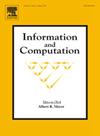通过单调性对猎人和兔子博弈的进一步结果
IF 1
4区 计算机科学
Q3 COMPUTER SCIENCE, THEORY & METHODS
引用次数: 0
摘要
猎人和兔子的游戏是在图形G上进行的,其中猎人玩家在每轮中射击k个顶点,而兔子玩家占据一个未知顶点,如果没有射击,则必须移动到邻近的顶点。当且仅当兔子没有被无限射击时,兔子玩家获胜。图G的猎人数h(G)是使猎人玩家有获胜策略的最小k。我们提出了一个单调性的概念,体现在单调猎人数mh(G)中,对于这个游戏来说,一个已经被射击的顶点“必须不再承载兔子”。我们证明了pw(G)≤mh(G)≤pw(G)+1对于任何路径宽度为pw(G)的图G,这意味着计算,甚至近似mh(G)是np困难的。然后,我们证明了在分裂图、区间图、图和树中,mh(G)可以在多项式时间内计算出来。这些结果通过结构表征,将单调猎人数与路径宽度联系起来。在所有这些情况下,我们要么指定猎人数,要么表明h和mh之间可能存在任意间隙,也就是说,单调性没有帮助。特别地,对于每一个k≥3,我们构造一个h(T)=2且mh(T)=k的树T。我们通过证明计算h (p)来得出结论。, mh)是由顶点覆盖数参数化的FPT。本文章由计算机程序翻译,如有差异,请以英文原文为准。
Further results on the Hunters and Rabbit game through monotonicity
The Hunters and Rabbit game is played on a graph G where the Hunter player shoots at k vertices in every round while the Rabbit player occupies an unknown vertex and, if not shot, must move to a neighbouring vertex. The Rabbit player wins if and only if it is not shot indefinitely. The hunter number of a graph G is the minimum k such that the Hunter player has a winning strategy. We propose a notion of monotonicity, embodied in the monotone hunter number , for this game imposing that a vertex that has already been shot “must not host the rabbit anymore”.
We show that for any graph G with pathwidth , implying that computing, or even approximating, is NP-hard. Then, we show that can be computed in polynomial time in split graphs, interval graphs, cographs and trees. These results go through structural characterisations which relate the monotone hunter number with the pathwidth. In all these cases, we either specify the hunter number or show that there may be an arbitrary gap between h and mh, i.e., that monotonicity does not help. In particular, for every , we construct a tree T with and . We conclude by proving that computing h (resp., mh) is parameterised by the vertex cover number.
求助全文
通过发布文献求助,成功后即可免费获取论文全文。
去求助
来源期刊

Information and Computation
工程技术-计算机:理论方法
CiteScore
2.30
自引率
0.00%
发文量
119
审稿时长
140 days
期刊介绍:
Information and Computation welcomes original papers in all areas of theoretical computer science and computational applications of information theory. Survey articles of exceptional quality will also be considered. Particularly welcome are papers contributing new results in active theoretical areas such as
-Biological computation and computational biology-
Computational complexity-
Computer theorem-proving-
Concurrency and distributed process theory-
Cryptographic theory-
Data base theory-
Decision problems in logic-
Design and analysis of algorithms-
Discrete optimization and mathematical programming-
Inductive inference and learning theory-
Logic & constraint programming-
Program verification & model checking-
Probabilistic & Quantum computation-
Semantics of programming languages-
Symbolic computation, lambda calculus, and rewriting systems-
Types and typechecking
 求助内容:
求助内容: 应助结果提醒方式:
应助结果提醒方式:


